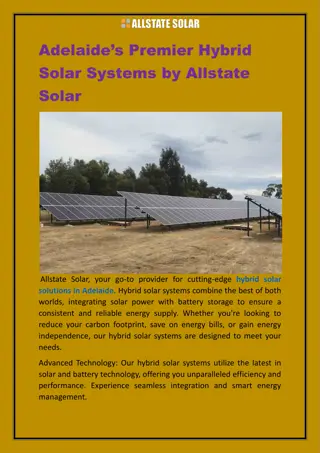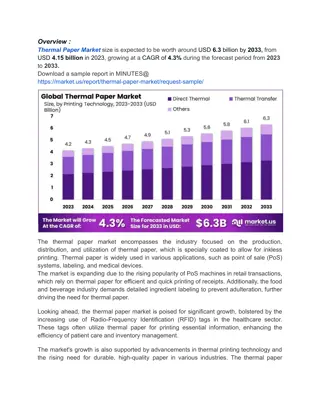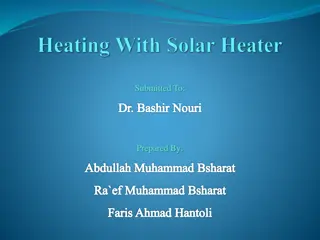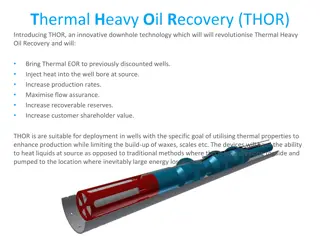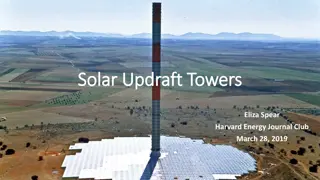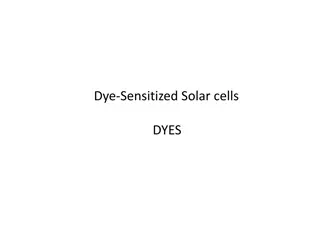Understanding Solar Thermal Technology Basics
This content covers the basics of solar thermal technology, including insolation, passive solar design, and active solar systems for producing hot water. It explains the uses of solar thermal energy in domestic, commercial, and pool heating applications. The efficiency of solar thermal panels compared to PV panels and factors affecting insolation are discussed, highlighting how solar thermal systems can be effectively utilized across different regions based on sunlight exposure.
Download Presentation

Please find below an Image/Link to download the presentation.
The content on the website is provided AS IS for your information and personal use only. It may not be sold, licensed, or shared on other websites without obtaining consent from the author. Download presentation by click this link. If you encounter any issues during the download, it is possible that the publisher has removed the file from their server.
E N D
Presentation Transcript
Solar Thermal Basics SOLAR THERMAL BASICS Except where otherwise noted these materials are licensed Creative Commons Attribution 4.0 (CC BY)
The objective of this unit is to present the student with some basic terms relating to solar thermal technology. Upon completion, the student will have an understanding of the following: Insolation Sun paths Panel tilt Direct, indirect and isolated passive solar Five elements of passive solar design Objectives Active solar Solar Thermal Basics
Solar Thermal systems produce hot water, not electricity. Possible uses include: Domestic Hot Water (DHW): Hot water used for sinks, laundry, etc. Pool Heating: Very economical way to heat a large pool Space Heating : Supplemental heating for one s home Commercial Uses: Heated water for car wash or for cleaning dairy milking machines Solar Thermal Energy Defined Note that solar thermal systems cannot supply 100% of the heated water for homes year round. Solar Thermal Basics
Solar thermal panels are more efficient than solar PV panels. The drawback is that PV systems can be connected to a battery for storage or the grid. A thermal system needs a large area to store excess. Solar Thermal Electric Energy Generation Queenwe [CC BY-SA 4.0]. Retrieved from https://commons.wikimedia.org/wiki/File:2015_Solar_Thermal_Electric_Energy_Generation_Profile.png Solar Thermal Basics
Solar thermal can be used effectively across the country. Directly related to sun hitting the surface Based on insolation measured in BTUs/ft2/day BTU is defined as the amount of energy necessary to heat one pound of water one degree Fahrenheit. Insolation depends on the area of the country where one resides: Seattle, WA has one of lowest yearly averages. Southern Arizona has one of the highest yearly averages. Where does solar thermal work? Factors affecting insolation Cloudiness Seattle gets less insolation than Montana or Idaho, and yet they are all at same latitude. Sun s path The movement of the sun over one s house every day. The angle of the sun to the earth. The sun is lower in the sky during winter months and strikes the earth s surface at a greater angle, causing less insolation. Solar Thermal Basics
Insolation Map The National Renewable Energy Laboratory [Public Domain]. Retrieved from https://www.nrel.gov/gis/solar.html Solar Thermal Basics
The sun is never directly overhead at noon; it is always shining from the south. Solar panels produce the most energy when pointed at the sun. Panels should be south-facing. Panels are forgiving if faced between southeast and southwest. 90% of the sun s power is available. Seasonal Sun Path at 23 N Latitude Hartz [CC BY-SA 3.0]. Retrieved from https://upload.wikimedia.org/wikipedia/commons/thumb/1/16/Solar_altitude.svg/512px-Solar_altitude.svg.png Solar Thermal Basics
Latitude lines are horizontal rings around the earth parallel to the equator. Elkader, Iowa latitude 42.8 N Kansas City, Kansas latitude 39.09 N Austin, Texas latitude 30.2 N If you tilt the panels steeper than the location s latitude, it will increase the panel s output in the late fall, winter, and early spring. If the panels are mounted at a flatter angle than the location s latitude, the panels will produce more efficiently in the summer months. Panel Tilt Iowa Energy Center. Solar PV Energy Guide. Retrieved from https://www.iowaeconomicdevelopment.com/userdocs/programs/15302_IEC_SolarEnergyGuide_Web.pdf Solar Thermal Basics
Passive solar energy is a means of harnessing the natural light and heat energy produced by the sun, with no other input of energy. Three possible methods of passive solar include: Direct gain Uses south-facing windows Greenhouses have incorporated this idea for centuries. Indirect gain Uses a trombe wall This is a dark-colored masonry wall inside the windows to absorb radiation. Isolated gain Uses a sunroom Incorporates heat-absorbing materials in a room Passive Solar Thermal Solar Thermal Basics
The angle of the winter sun is used to reach into the house. Passive Solar Thermal United States Department of Energy [Public domain]. Retrieved from https://commons.wikimedia.org/wiki/File:Illust_passive_solar_d1.gif Solar Thermal Basics
Active solar thermal is the use of a collection device that absorbs the sun s heat energy, which is then transferred to a medium for use by a pump or fan. There are two types of active solar: Direct Circulation Involves the circulation of water or air directly into the solar collector where it is then transferred to the required medium. Useful in areas that do not experience freezing temperatures Indirect Circulation Uses a closed system that transfers heat into a storage tank Prevents the unwanted cooling of the heat transfer fluid Can be temperature-controlled Active Solar Thermal Solar Thermal Basics
Active Solar Thermal Direct Circulation SEDO [Public domain]. Retrieved from https://commons.wikimedia.org/wiki/File:Active_open_loop_solar_HW_system.png Conduction and convection is occurring in the tank. Solar Thermal Basics
Upon completion of this unit, students should be able to Define insolation Understand how insolation is affected Distinguish among the seasonal sun paths Understand the tilt angle Understand how passive and active solar differ Define direct and indirect terminology pertaining to solar thermal Conclusion This presentation was prepared by Northeast Iowa Community College under award EG-17-004 from the Iowa Energy Center. Any opinions, findings, and conclusions or recommendations expressed in this material are those of the author(s) and do not necessarily reflect the views of the Iowa Energy Center. Solar Thermal Basics







